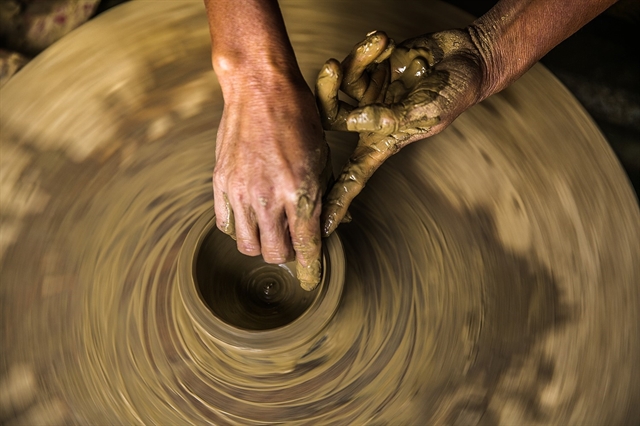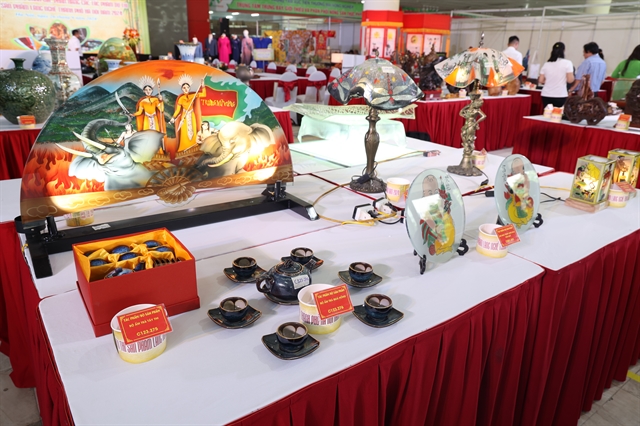Weather:
- Ha Noi 22oC
- Da Nang 22oC
- Ho Chi Minh 29oC

HÀ NỘI — Hà Nội's agriculture sector is pushing the development of craft villages associated with tourism that not only to bring benefits in terms of the economy, but also create jobs for local people and partly help preserve the cultural values of the capital city.
Talking about traditional craft villages in Hà Nội, people often think of Bát Tràng ceramic craft village, about 10km southeast of the city centre, in Bát Tràng Commune, in the district of Gia Lâm.
Through many ups and downs of history, the village still retains its tradition of making ceramic and pottery from the soil. Bát Tràng ceramic products not only serve people in their daily life, but also have high aesthetic value thanks to the amazing craftsmanship and artisans' creativity.
Using terracotta, Bát Tràng artisans can produce ceramic products in many different styles, sizes and types including items used for worship, such as candlesticks and wine jars, household items, like cups, bowls, plates, jars, vases and pots, along with decorative fine arts. Bát Tràng ceramics are handmade with traditional glaze colours such as blue, brown and turquoise.
"Currently, we have combined traditional and modern technique in our production process. It is a combination of the quintessence of ceramics, artisan ingenuity and advanced technology to make better ceramic products," said Hà Thị Vinh, director of Quang Vinh Ceramics Company Limited.
"Technology helps us carry out raw material processing and diversify the material sources, machinery helps shape and control quality and products' smoothness and high safety. So there is no room for warping and cracking, etc.
"Introducing technology into production also helps enterprises easier approach the international markets," she said.

Actively researching and innovating product designs, artisan Phạm Thanh Mai, director of Mai Linh Ceramics Co., Ltd., has found that there is a large market for cappuccino coffee cups - thick cups with a handle, able to keep the drink warmer longer.
Mai has skillfully combined the manual method of producing sophisticated ceramics with artistic creativity, bringing its own nuances and characteristics for the ceramic cappuccino cups.
According to Phạm Huy Khôi, chairman of Bát Tràng Commune People's Committee, there are more than 100 artisans, thousands of skilled workers, nearly 200 enterprises and about 1,000 households producing and trading ceramics in the Bát Tràng Village.
These businesses and enterprises have been creating jobs, ensuring stable lives for local workers and 4,000 to 5,000 workers from other localities, contributing to promoting economic growth and society development in the commune.
Bát Tràng was recognised as a tourist destination by the Hà Nội People's Committee in October 2019.
This was the result of a process of preserving, maintaining and promoting the traditional ceramic craft, the use of innovation and technology in production and the effort to improve product quality and designs by all households and enterprises, in addition to local people's active participation in tourism development and craft village promotion.

After the recognition, Bát Tràng Commune has promoted the application of 4.0 technology, deployed investment in a 'smart tourism' model, with the construction of a database of digital resources and maps on tangible and intangible cultural heritage. It combined tourism, services and commerce in the form of 3D movies, audio guides and multimedia, along with smart tours on apps.
The commune has also maintained and effectively exploited the Bát Tràng's portal, established tourist information centres and created QR codes to introduce its heritage relics in Vietnamese and English.
In particular, in order to create more attraction for tourism, Bát Tràng has organised many programmes encouraging local people to take part in the mural painting movement to create beautiful, friendly and attractive landscapes for tourists and at the same time preserving the environment.
Director of the Hà Nội Rural Development Department Nguyễn Văn Chí said that the development of craft villages associated with tourism played an important role in the economic structural transformation in rural areas. It contributes to building comprehensive and sustainable rural development, increasing incomes and improving people's living standards.

Every year, Bát Tràng welcomes about 100,000 tourists, many of which are international groups, to visit and shop for ceramic products.
The main income of the commune is from ceramic production and trading. The value of ceramic production and trade in the commune is estimated to reach over VNĐ2,000 billion (US$78.6 million) per year, the equivalent of an average annual income of the entire commune to over VNĐ90 million, per person.
Director of Hà Nội Department of Agriculture and Rural Development Nguyễn Xuân Đại said that under the city's plan, the department has recently coordinated closely with districts to review and plan other craft villages with tourism potential and then build craft village innovation centres alongside them.
The model is to create a sustainable development direction for Hà Nội's craft villages.
Officials are aware that when there is an overall development strategy and investment in the right direction, the craft villages, including Bát Tràng, will be the driving force to promote socio-economic growth, ensuring social security, while attracting domestic and foreign tourists to visit and experience the craft at the villages. VNS
*This article is coordinated by Hà Nội Rural Development Department.


